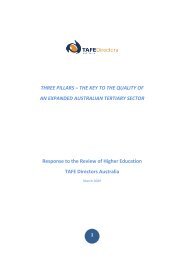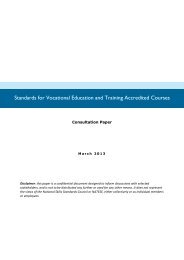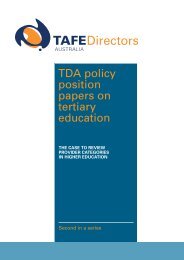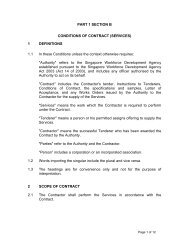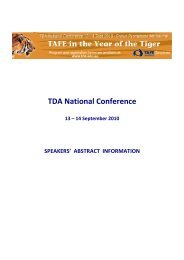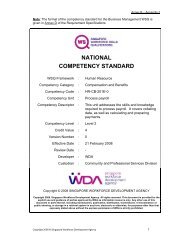Occasional Paper - TAFE Directors Australia
Occasional Paper - TAFE Directors Australia
Occasional Paper - TAFE Directors Australia
Create successful ePaper yourself
Turn your PDF publications into a flip-book with our unique Google optimized e-Paper software.
24<br />
<strong>TAFE</strong> IN THE YEAR OF THE TIGER<br />
Unlike other Anglophone countries, <strong>Australia</strong> has<br />
a highly differentiated tertiary education system<br />
with CBT in VET, and curriculum in higher education.<br />
Differentiated systems are effective when they lead<br />
to different labour market destinations that draw<br />
on the different knowledge base of each sector.<br />
However:<br />
• VET graduates from diplomas and advanced<br />
diplomas often compete with bachelor<br />
graduates for the same positions, and diplomas<br />
are being replaced by degrees as the entry level<br />
qualification in many occupations (Foster et al.<br />
2007; Karmel & Cully 2009)<br />
• the ‘fit’ between qualifications and occupations<br />
is quite loose, except for regulated occupations.<br />
In 2008, only 30.3% of VET graduates reported<br />
that they were working in the occupation<br />
directly associated with their VET qualification<br />
(NCVER 2008, Table 7)<br />
• most workers do not move into a different<br />
occupational skill level post-training in VET,<br />
including over two-thirds of those in low paid<br />
occupations and 86% of those in higher paid<br />
occupations (Pocock 2009).<br />
It is difficult to sustain arguments for differentiated<br />
curriculum in VET and higher education when<br />
graduates compete for the same jobs. It is also<br />
difficult to argue that CBT results in efficiencies by<br />
training people for specific workplace tasks or roles<br />
when most people will not be employed in those<br />
jobs. And, it is difficult to sustain an argument that<br />
VET qualifications directly increase access to higher<br />
skilled occupations if this is measured by transition<br />
from a lower to a higher skill level. Yet these are the<br />
narrow purposes of VET qualifications as defined in<br />
policy, and these are how they should be measured.<br />
Outcomes for VET graduates from 2003–2009 show<br />
that the percentage in employment after training<br />
peaked in 2007 but otherwise was not much<br />
different; and, the percentage in further study after<br />
training declined by almost 8%. Demand for tertiary<br />
education declines with strong labour markets, but<br />
strong labour markets also in part account for the<br />
increase in employment outcomes. Some groups<br />
experienced little or no growth in employment<br />
during this period, particularly young people<br />
aged between 15–19 years. Their employment<br />
outcomes declined from 2001–2008 by almost<br />
3% and their further study outcomes declined by<br />
5%. Equity groups are over-represented in low level<br />
VET qualifications and languish in Certificates I and<br />
II which have appalling employment and further<br />
study outcomes.<br />
The new definition of CBT does not address the<br />
fundamental problem which is that learning<br />
outcomes are still based on workplace tasks and<br />
roles. This means that units of competency are based<br />
on a disaggregated view of the workplace, so that<br />
‘becoming competent’ consists of aggregations of<br />
workplace tasks and roles that have been defined<br />
independently of each other. Moreover, it is still<br />
a requirement that knowledge ‘should only be<br />
included if it refers to knowledge actually applied at<br />
work’ (DEEWR 2009).<br />
So, rather than providing students with access to<br />
the applied disciplinary knowledge that underpins<br />
occupational practice (as in the professions),<br />
they are only provided with contextually specific<br />
applications of knowledge. This is because<br />
knowledge is delocated from the applied disciplines<br />
and tied to specific workplace requirements.<br />
Students may be able to associate a contextually<br />
specific application of knowledge with a specific<br />
context, but it does not help them if they need






